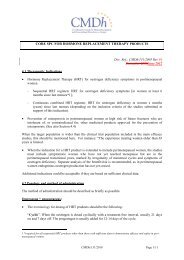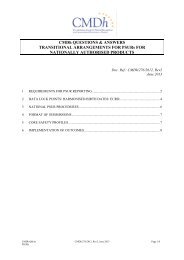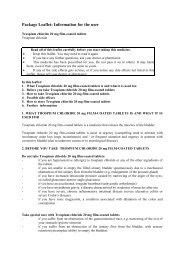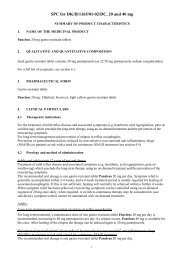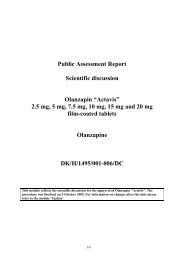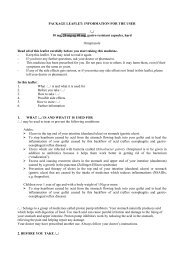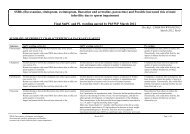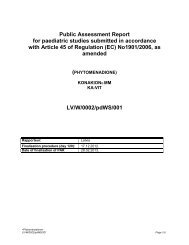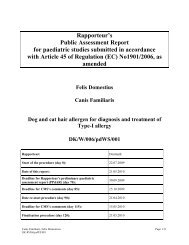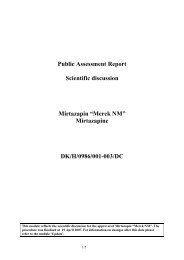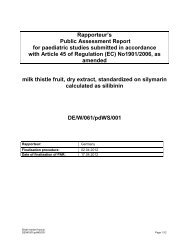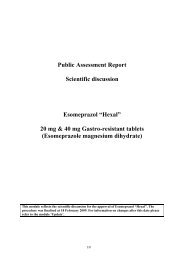ESP Pharma” 10 mg film-coated tablets Montelukast sodium DK/H/17
ESP Pharma” 10 mg film-coated tablets Montelukast sodium DK/H/17
ESP Pharma” 10 mg film-coated tablets Montelukast sodium DK/H/17
Create successful ePaper yourself
Turn your PDF publications into a flip-book with our unique Google optimized e-Paper software.
Public Assessment Report<br />
Scientific discussion<br />
<strong>Montelukast</strong> ”<strong>ESP</strong> <strong>Pharma”</strong><br />
<strong>10</strong> <strong>mg</strong> <strong>film</strong>-<strong>coated</strong> <strong>tablets</strong><br />
<strong>Montelukast</strong> <strong>sodium</strong><br />
<strong>DK</strong>/H/<strong>17</strong><strong>17</strong>/001/DC<br />
This module reflects the scientific discussion for the approval of <strong>Montelukast</strong> ”<strong>ESP</strong> <strong>Pharma”</strong>.<br />
The procedure was finalised on 22 March 20<strong>10</strong>. For information on changes after this date<br />
please refer to the module ‘Update’.<br />
1/7
I. INTRODUCTION<br />
Based on the review of the quality, safety and efficacy data, the Member States have granted a<br />
marketing authorisation for <strong>Montelukast</strong> ”Esp <strong>Pharma”</strong> <strong>10</strong> <strong>mg</strong> <strong>film</strong>-<strong>coated</strong> <strong>tablets</strong>, from <strong>ESP</strong> Pharma<br />
Limited. The product was authorised in Denmark on 2 July 20<strong>10</strong>. The product is indicated for the<br />
treatment of asthma as add-on therapy in those patients 15 years of age and older with mild to<br />
moderate persistent asthma who are inadequately controlled on inhaled corticosteroids and in whom<br />
“as-needed” short acting β-agonists provide inadequate clinical control of asthma. In those asthmatic<br />
patients 15 years of age and older in whom <strong>Montelukast</strong> ”<strong>ESP</strong> <strong>Pharma”</strong> is indicated in asthma,<br />
<strong>Montelukast</strong> ”<strong>ESP</strong> <strong>Pharma”</strong> can also provide symptomatic relief of seasonal allergic rhinitis.<br />
<strong>Montelukast</strong> ”<strong>ESP</strong> <strong>Pharma”</strong> is also indicated in the prophylaxis of asthma in patients 15 years of age<br />
and older in which the predominant component is exercise-induced bronchoconstriction.<br />
<strong>Montelukast</strong> is used as an anti-ashmatics for systemic use. <strong>Montelukast</strong> is an orally active compound<br />
which binds with high affinity and selectively to the CycLT1 receptor. The cycteinyl leukotrines<br />
(LTC4, LTD4, LTE4) are potent inflammatory eicosanoids released form various cells including mast<br />
cells and eosinophils. These important pro-ashmatic mediator bind to cycteinly leukotriene receptors<br />
(CysLT) found in the human airway and cause airway actions, including bronchoconstriction, mucous<br />
secretions, vascular permeability and eosinophil recruitment. Bronchodilation was observed within 2<br />
hours of oral administration.<br />
This decentralised procedure concerns a generic application claiming essential similarity with the<br />
reference product Singulair <strong>10</strong> <strong>mg</strong> <strong>film</strong>-<strong>coated</strong> <strong>tablets</strong> which has been authorised in the RMS since<br />
January 20, 1998.<br />
A bioequivalence study has been preformed with Singulair <strong>10</strong> <strong>mg</strong> <strong>film</strong>-<strong>coated</strong> <strong>tablets</strong>, Merck Sharp &<br />
Dohme, from the German market, as the reference product.<br />
The marketing authorisation is granted based on article <strong>10</strong>.1 of Directive 2001/83/EC.<br />
II. QUALITY ASPECTS<br />
II.1 Introduction<br />
Each <strong>film</strong>-<strong>coated</strong> tablet contains montelukast <strong>sodium</strong> equivalent to <strong>10</strong> <strong>mg</strong> of montelukast.<br />
The tablet is a beige, square, biconvex <strong>film</strong>-<strong>coated</strong> tablet with M engraved on one side.<br />
The product is packed in OPA-Al-PVC/Al blister packs in various pack sizes.<br />
The excipients in the tablet core are: Cellulose, microcrystalline; hydroxypropylcellulose;<br />
croscarmellose <strong>sodium</strong>; lactose monohydrate and magnesium stearate.<br />
The <strong>film</strong>-coating consists of: Lactose monohydrate; hypromellose 15cP; titanium dioxide (E<strong>17</strong>1);<br />
macrogol 4000; iron oxide yellow (E<strong>17</strong>2) and iron oxide red (E<strong>17</strong>2).<br />
Compliance with Good Manufacturing Practice<br />
The RMS has been assured that acceptable standards of GMP (see Directive 2003/94/EC) are in place<br />
for this product type at all sites responsible for the manufacturing of the active substance as well as for<br />
the manufacturing and assembly of this product prior to granting its national authorisation.<br />
2/7
II.2 Drug Substance<br />
The product contains montelukast <strong>sodium</strong> as active substance which is not monographed in Ph.Eur.<br />
INN: <strong>Montelukast</strong> <strong>sodium</strong><br />
Chemical name(s): [R-(E)]-1-[[[1-[3-[2-(7-chloro-2-quinolinyl)ethenyl]phenyl]-3-[2-(1-hydroxy-1methylethyl)phenyl]propyl]thio]methyl]cyclopropaneacetic<br />
acid, mono<strong>sodium</strong><br />
salt.<br />
Molecular formula: C35H35ClNNaO3S<br />
Molecular mass: 608.18<br />
Structural formula:<br />
<strong>Montelukast</strong> <strong>sodium</strong> is a white to off white to light yellow amorphous powder. It is freely soluble in<br />
methanol, ethanol and water and practically insoluble in acetonitrile.<br />
<strong>Montelukast</strong> <strong>sodium</strong> has one asymmetric centre and is the R-isomer.<br />
A crystalline and an amorphous form are known. Some solvates and mixtures thereof are also known.<br />
<strong>Montelukast</strong> <strong>sodium</strong> is hygroscopic according to the definition in Ph.Eur.<br />
The applicant sources the substance from two suppliers. The documentation from both suppliers is<br />
presented in European Drug Master Files in CTD format.<br />
Starting material synthesis is adequately described.<br />
Specifications are satisfactory. Validation data are provided for relevant methods and are satisfactory.<br />
The applicant specification for montelukast <strong>sodium</strong> reflects parameters and limits applied by both<br />
ASMs. All necessary analysis methods and validations are provided.<br />
Appropriate retest periods have been set based on the provided stability data.<br />
II.3 Medicinal Product<br />
The product is a <strong>film</strong>-<strong>coated</strong> tablet and its composition is adequately described. The development of<br />
the product has been satisfactorily performed and explained. No incompatibilities between the active<br />
substance and the excipients are observed. Excipients are those commonly used for manufacture of a<br />
<strong>film</strong> <strong>coated</strong> tablet. The packaging material is standard and shown suitable by the presented stability<br />
studies.<br />
Product manufacture is by standard processing and employs a wet granulation process followed by<br />
tabletting and <strong>film</strong> coating. Manufacture is suitably described. Validation data are provided for three<br />
pilot scale batches. The manufacturing instructions describe sub-lot processing for granulation with<br />
subsequent blending to a large homogeneous batch blend. This aspect of manufacture will be fully<br />
validated on commercial batches and the number of sublots limited in line with the validation data.<br />
The data provided at a pilot scale otherwise support a reproducible product manufacture when sub-lot<br />
granulation is not employed.<br />
The finished product specification is standard for the pharmaceutical form and includes relevant<br />
physicochemical, ID, assay and purity tests. Separate release and shelf-life specifications are provided<br />
3/7
where the latter employ slightly wider related substances limits. Stability data provided to date support<br />
widening of the sulphoxide and total impurities limits to the extent suggested.<br />
Batch analysis data are provided for three pilot scale batches showing compliance with the release<br />
requirements and confirming consistency of product manufacture.<br />
Stability data are provided for 2 batches of each strength stored in the proposed market packaging. A<br />
shelf-life of 3 years when stored in the original package in order to protect from light and moisture is<br />
accepted.<br />
III. NON-CLINICAL ASPECTS<br />
This product is a generic formulation of Singulair <strong>10</strong> <strong>mg</strong> <strong>film</strong>-<strong>coated</strong> <strong>tablets</strong>, which is available on the<br />
European market. No new preclinical data have been submitted, and therefore the application has not<br />
undergone preclinical assessment. This is acceptable for this type of application<br />
Environmental risk assessment<br />
The product is intended as a substitute for other identical products on the market. The approval of this<br />
product will not result in an increase in the total quantity of montelukast <strong>sodium</strong> released into the<br />
environment. It does not contain any component, which results in an additional hazard to the<br />
environment during storage, distribution, use and disposal.<br />
IV. CLINICAL ASPECTS<br />
IV.1 Introduction<br />
<strong>Montelukast</strong> <strong>sodium</strong> is a well-known active substance with established efficacy and tolerability.<br />
For this generic application, the MAH has submitted three single dose bioequivalence studies, though<br />
two of these relate to alternative dosage forms and are therefore not directly relevant to the application<br />
and hence will not be reviewed here. The single dose study on the <strong>10</strong> <strong>mg</strong> <strong>film</strong>-<strong>coated</strong> <strong>tablets</strong> under<br />
fasting conditions compares the pharmacokinetic profile of the test product <strong>Montelukast</strong> ”<strong>ESP</strong><br />
<strong>Pharma”</strong> <strong>10</strong> <strong>mg</strong> <strong>film</strong>-<strong>coated</strong> <strong>tablets</strong> with the pharmacokinetic profile of the reference product Singulair<br />
<strong>10</strong> <strong>mg</strong> <strong>film</strong>-<strong>coated</strong> <strong>tablets</strong>, Merck Sharp & Dohme, from the German market.<br />
The study was a single centre, open label, randomised, single dose, two-way crossover study<br />
conducted under fasting conditions with a wash out period of 7 days between administrations. <strong>10</strong> <strong>mg</strong><br />
was administered in each period with 240 ml water under yellow monochromatic light, after an<br />
overnight fast of at least <strong>10</strong> hours. Subjects were confined to the clinical research centre from at least<br />
13 hours prior to drug administration until after the 24 hour post-dose blood draw in each period.<br />
Water was permitted ad lib until 1 hour before dosing and again 2 hours after dosing, otherwise ad<br />
libitum. Standardised meals were provided at 4, 8 and 12 hours post dose in each period.<br />
Blood sampling was performed predosing (within 1 hour) and at 0.5, 1.0, 1.333, 1.667, 2.0, 2.25, 2.5,<br />
2.75, 3.0, 3.5, 3.75, 4.0, 5.0, 6.0, 7.0, 8.0, 12.0, 16.0 and 24.0 hours post-dose in each period under<br />
yellow monochromatic light.<br />
36 healthy volunteers were randomised into the study and 33 completed.<br />
Primary pharmacokinetic variables were AUC0-t, AUC0-∞ and Cmax. Secondary parameters were AUC0t/AUC0-∞,<br />
tmax, Kel, and t½. Safety was also analysed.<br />
90% CIs for AUC0-t and Cmax are to be within 80-125% in order to conclude bioequivalence.<br />
4/7
Table 1. Pharmacokinetic parameters (non-transformed values; arithmetic mean ± SD, tmax median,<br />
range)<br />
Treatment AUC0-t<br />
Test<br />
(S.D.)<br />
Reference<br />
(S.D.)<br />
*Ratio (90% CI)<br />
Intra-subject CV (%)<br />
ng.h/ml<br />
AUC0-∞<br />
5/7<br />
ng.h/ml<br />
Cmax<br />
ng/ml<br />
tmax<br />
h<br />
T1/2<br />
3081.133 3183.654 502.622 3.50 4.82<br />
(893.562) (939.577) (140.727) (2.25-6.00) (0.87)<br />
3072.972 3<strong>17</strong>8.813 474.541 2.67 4.55<br />
(938.166) (982.893) (160.197) (1.67-8.00) (1.<strong>10</strong>)<br />
99<br />
99<br />
<strong>10</strong>8 -0.500 -<br />
92 -<strong>10</strong>8 92 -<strong>10</strong>7 96 -121 -1.500 to<br />
0.750<br />
19.81% 18.96% 28.37% - -<br />
AUC0-∞ area under the plasma concentration-time curve from time zero to infinity<br />
AUC0-t area under the plasma concentration-time curve from time zero to t hours<br />
Cmax maximum plasma concentration<br />
Tmax time for maximum concentration<br />
T1/2 half-life<br />
*log-transformed values<br />
The 90% confidence intervals for AUC0-t, AUC0-∞ and Cmax are within the acceptance range of 80-<br />
125%.<br />
Based on the submitted bioequivalence studies, <strong>Montelukast</strong> ”<strong>ESP</strong> <strong>Pharma”</strong> <strong>10</strong> <strong>mg</strong> <strong>film</strong>-<strong>coated</strong> <strong>tablets</strong><br />
are considered bioequivalent with Singulair <strong>10</strong> <strong>mg</strong> <strong>film</strong>-<strong>coated</strong> <strong>tablets</strong>.<br />
Tolerability of the test products is acceptable and not significantly different from reference products.<br />
The RMS has been assured that the bioequivalence study has been conducted in accordance with<br />
acceptable standards of Good Clinical Practice (GCP, see Directive 2005/28/EC) and Good<br />
Laboratory Practice (GLP, see Directives 2004/9/EC and 2004/<strong>10</strong>/EC).<br />
IV.2 Risk management plan & Pharmacovigilance system<br />
<strong>Montelukast</strong> was first approved in 1997, and there is now more than <strong>10</strong> years post-authorisation<br />
experience with the active substance. The safety profile of montelukast can be considered to be well<br />
established and no product specific pharmacovigilance issues were identified pre- or postauthorisation<br />
which are not adequately covered by the current SPC. Additional risk minimisation activities have not<br />
been identified for the reference medicinal product. The MAH has a pharmacovigilance system at their<br />
disposal, which is based on the current European legislation.<br />
The Pharmacovigilance system described fulfils the requirements and provides adequate evidence that<br />
the applicant has the services of a qualified person responsible for pharmacovigilance and has the<br />
necessary means for the identification and notification of any potential risks occurring either in the<br />
Community or in a third country.<br />
V. PRODUCT INFORMATION<br />
SmPC and Package leaflet<br />
h
The content of the SmPC and package leaflet approved during the decentralised procedure is in<br />
accordance with that accepted for the reference product Singulair <strong>film</strong>-<strong>coated</strong> <strong>tablets</strong> marketed by<br />
Merck Sharp & Dohme.<br />
Readability test<br />
The package leaflet has been evaluated via a user consultation study in accordance with the<br />
requirements of Articles 59(3) and 61(1) of Directive 2001/83/EC. The language used for the purpose<br />
of user testing the package leaflet was English. The test consisted of a pilot test with 3 participants,<br />
followed by one round with <strong>10</strong> participants only, since the package leaflet for the <strong>Montelukast</strong><br />
chewable <strong>tablets</strong> had already been user tested and the applicant had submitted a table of comparison of<br />
the package leaflet for the chewable <strong>tablets</strong> and the <strong>10</strong> <strong>mg</strong> <strong>film</strong>-<strong>coated</strong> <strong>tablets</strong>. Based on the<br />
comparison it was deemed necessary to test <strong>10</strong> subjects and present the results of the test (the results<br />
of the user test of the package leaflet for the <strong>10</strong> <strong>mg</strong> <strong>film</strong>-<strong>coated</strong> <strong>tablets</strong> were presented as an addendum<br />
to that of the chewable <strong>tablets</strong>).<br />
The results show that the package leaflet meets the criteria for readability as set out in the Guideline<br />
on the readability of the label and package leaflet of medicinal products for human use.<br />
VI. OVERALL CONCLUSION, BENEFIT/RISK ASSESSMENT AND<br />
RECOMMENDATION<br />
<strong>Montelukast</strong> ”<strong>ESP</strong> <strong>Pharma”</strong> <strong>10</strong> <strong>mg</strong> <strong>film</strong>-<strong>coated</strong> <strong>tablets</strong> have a proven chemical-pharmaceutical quality<br />
and are generic forms of Singulair <strong>10</strong> <strong>mg</strong> <strong>film</strong>-<strong>coated</strong> <strong>tablets</strong>. Singulair is a well-known medicinal<br />
product with an established favourable efficacy and safety profile.<br />
Bioequivalence has been shown to be in compliance with the requirements of European guidance<br />
documents.<br />
The MAH has provided written confirmation that systems and services are in place to ensure<br />
compliance with their pharmacovigilance obligations.<br />
The SmPC, package leaflet and labelling are in the agreed templates and are in agreement with other<br />
montelukast containing products.<br />
Agreement between Member States was reached during a written procedure. There was no discussion<br />
in the CMD(h). The Concerned Member States, on the basis of the data submitted, considered that<br />
essential similarity has been demonstrated for <strong>Montelukast</strong> ”<strong>ESP</strong> <strong>Pharma”</strong> with the reference product,<br />
and have therefore granted a marketing authorisation. The decentralised procedure was finalised on 22<br />
March 20<strong>10</strong>. <strong>Montelukast</strong> ”<strong>ESP</strong> <strong>Pharma”</strong> is authorised in Denmark on 2 July 20<strong>10</strong>.<br />
A European harmonised birth date has been allocated (1997-06-25) and subsequently the first data<br />
lock point for montelukast is July 2012, after which the PSUR submission cycle is 3 years.<br />
The date for the first renewal will be: 22 March 2015.<br />
The following post-approval commitments have been made during the procedure:<br />
a) The EDMF for montelukast <strong>sodium</strong> will be harmonised following completion of this DC<br />
procedure.<br />
b) A commitment is made that all commercial batches will be fully validated and sublots limited<br />
in line with validation data for commercial batches.<br />
c) A commitment is made to perform assay and related substances HPLC testing at the 24<br />
months and 36 months time points with an extended run time of up to 40 minutes.<br />
6/7
d) Stability data supporting the proposed holding times of one month for powder blend, one<br />
month for tablet cores and 3 months for bulk <strong>coated</strong> <strong>tablets</strong> will be generated on the first<br />
production scale batches and will be submitted when available.<br />
7/7



